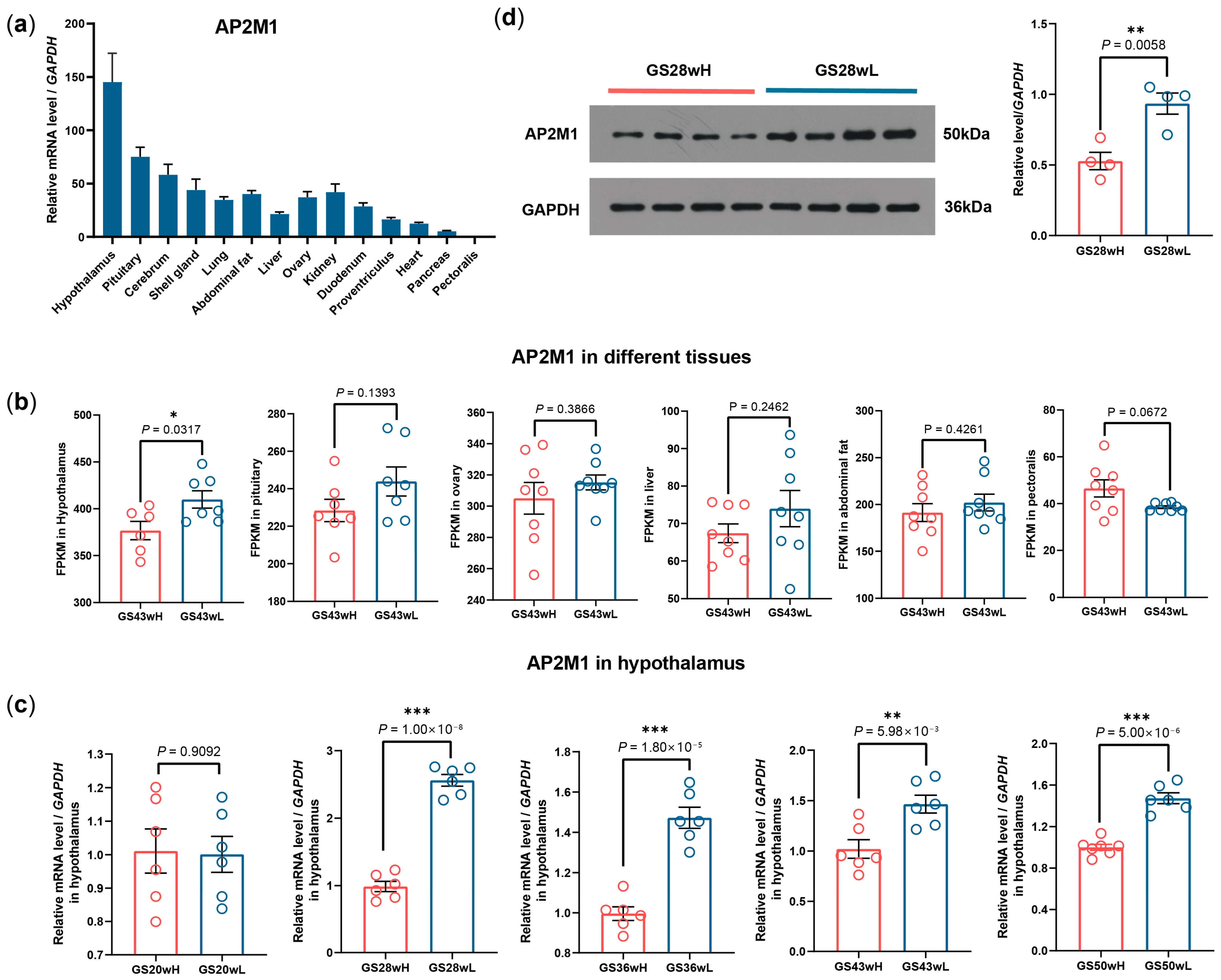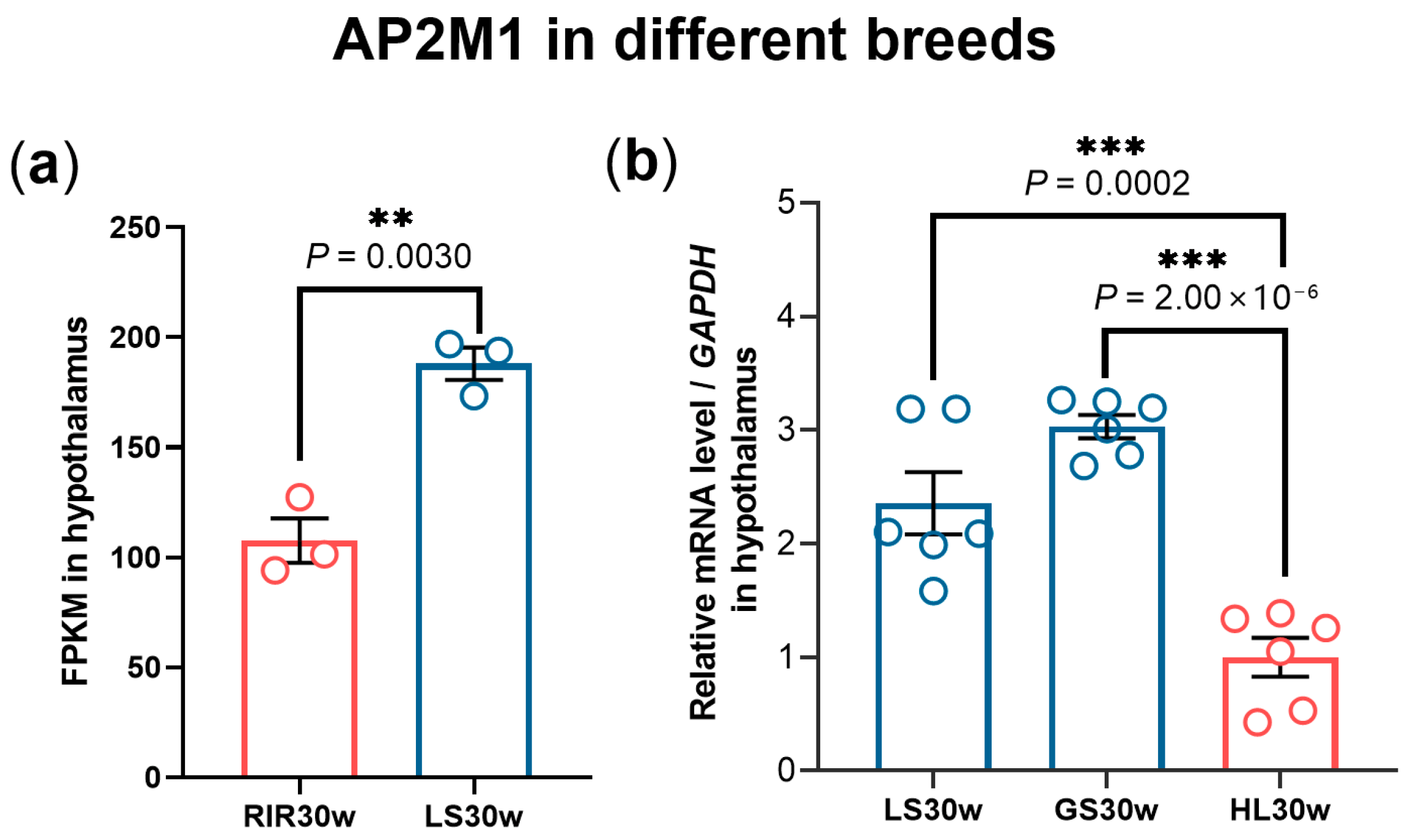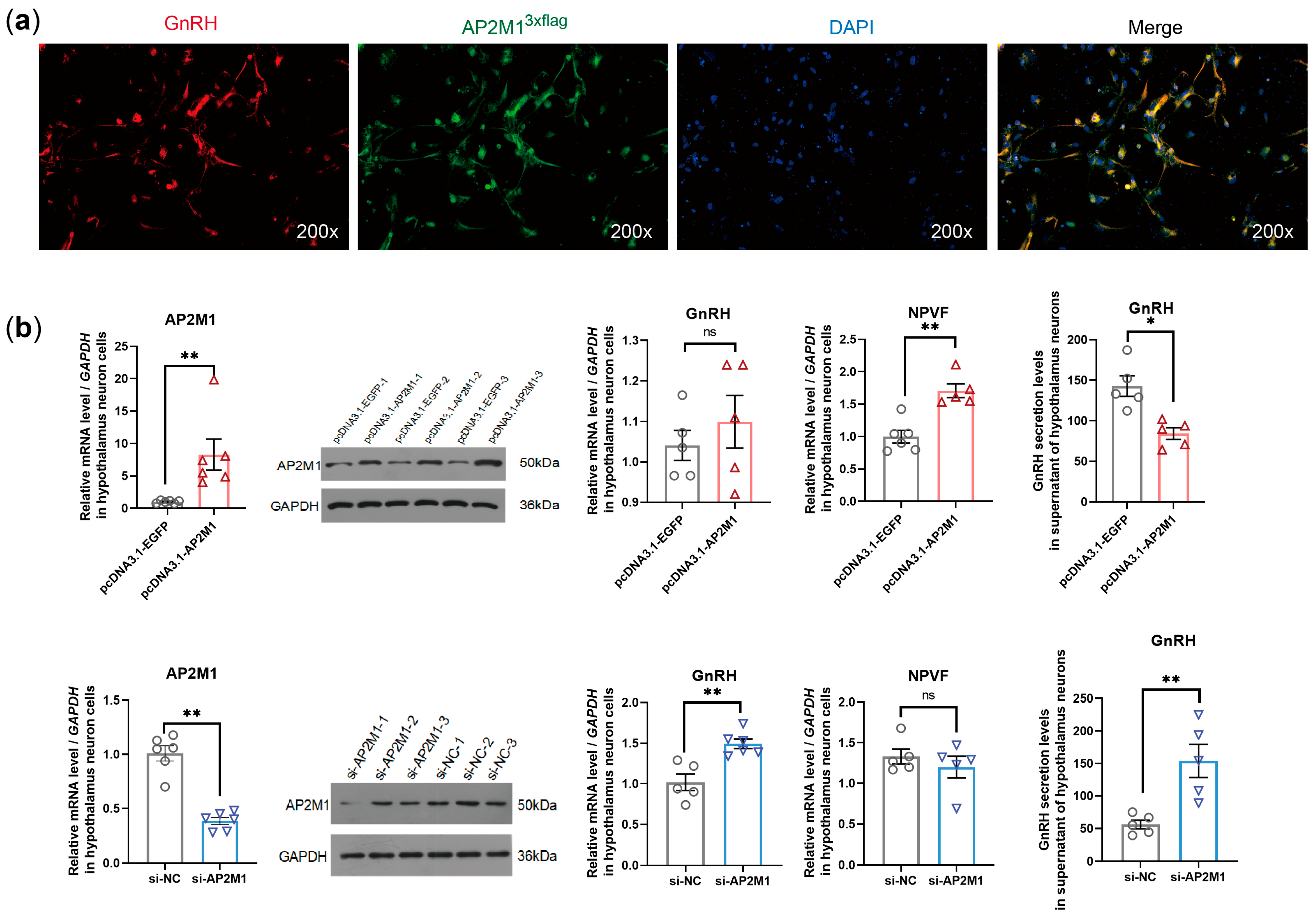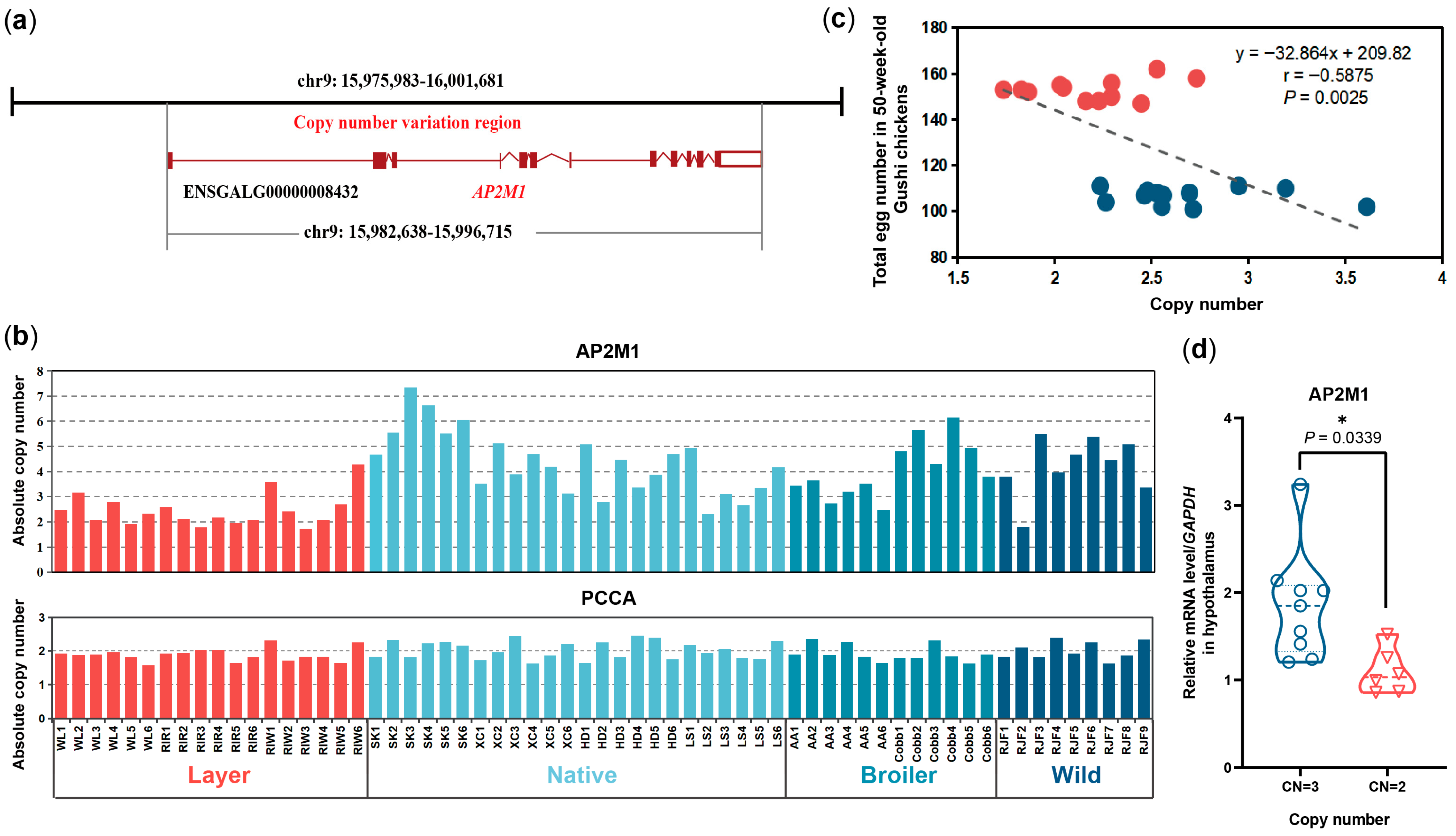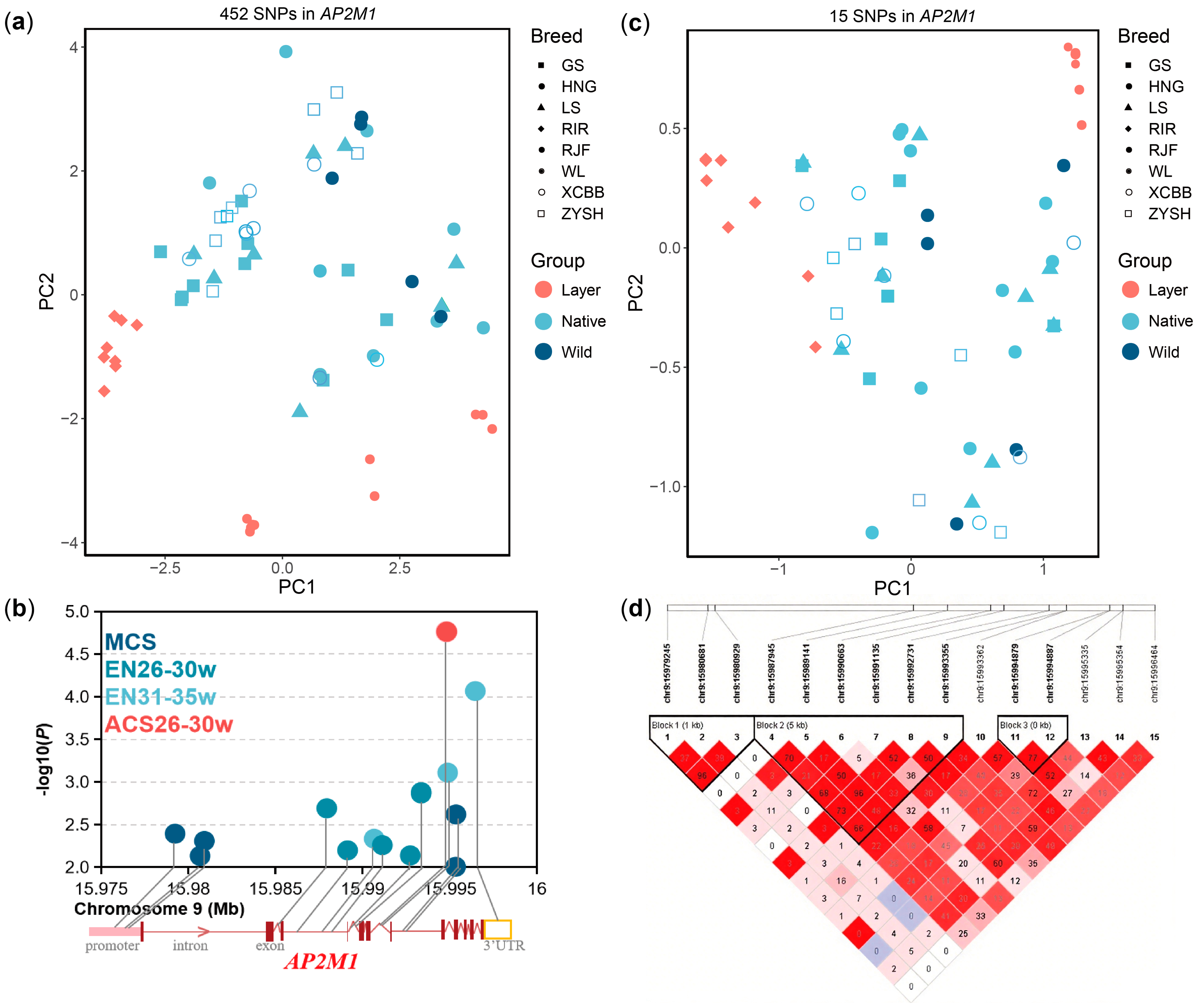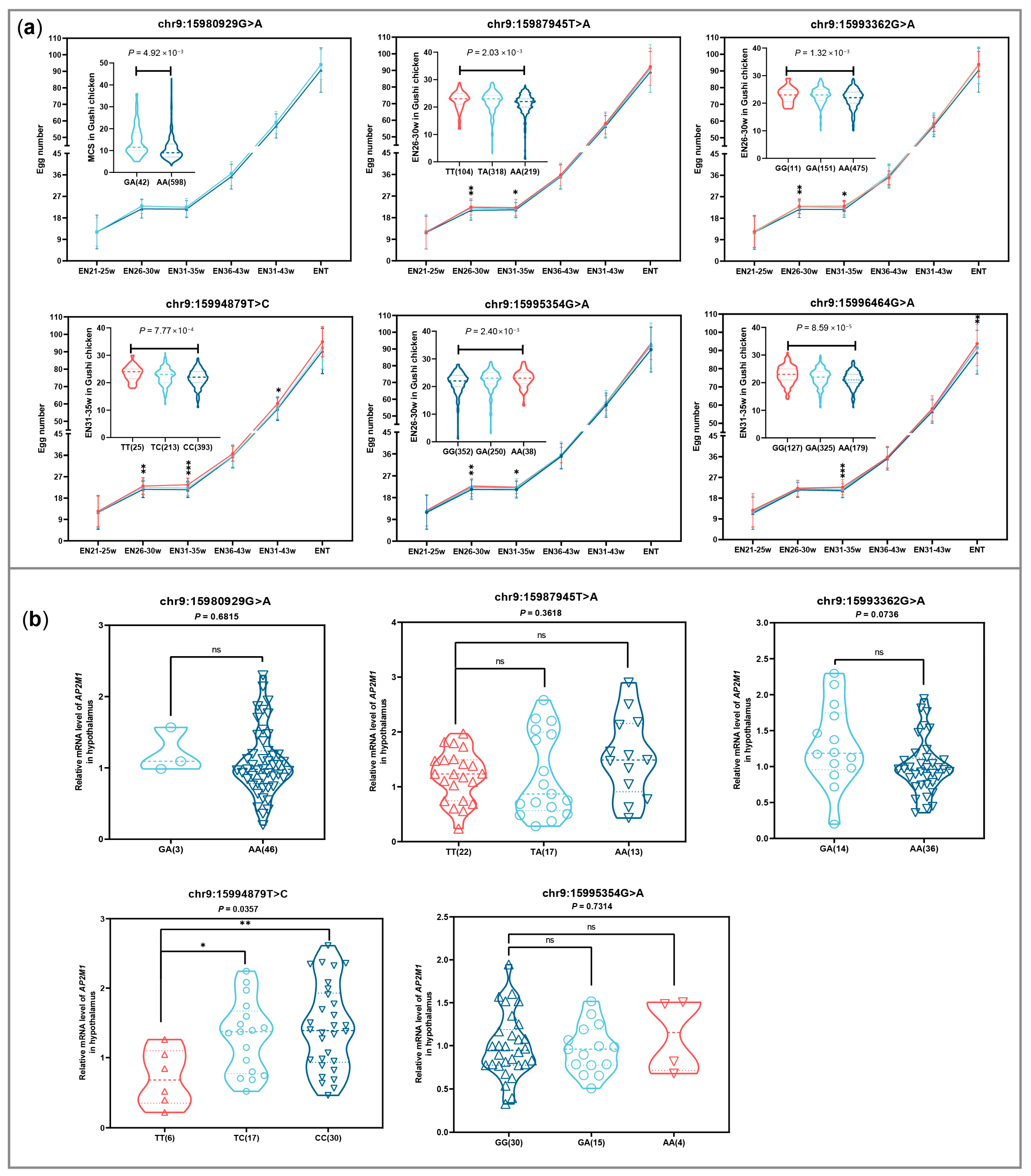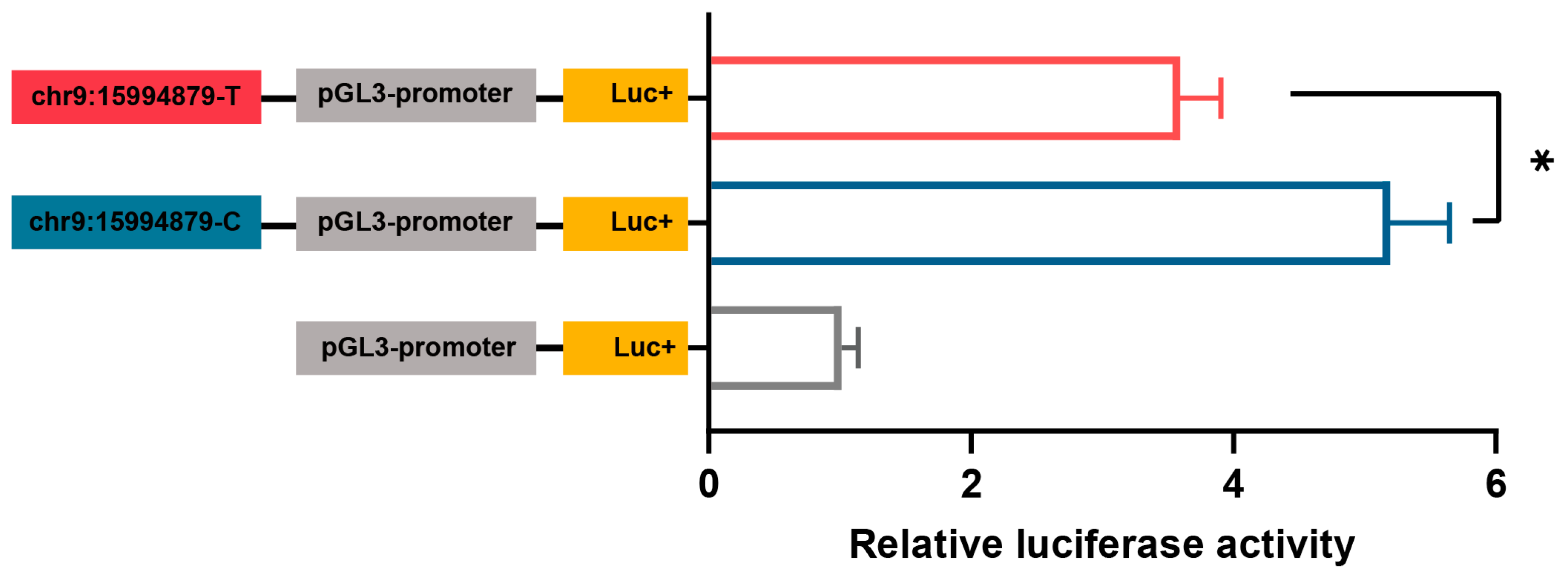1. Introduction
Egg production trait is one of the most core economic traits in poultry production and thus has always been a key focus in the selection of chicken laying-oriented breeding. Due to the fact that the egg production trait is a complex trait regulated by multiple micro-effect genes, the selection accuracy via traditional breeding strategies is greatly limited [
1]. Deciphering the genetic basis of egg production trait and aggregating its key dominant genes or genetic markers will be conducive to the genetic improvement of chicken laying-oriented breeding.
Native chicken breeds possess remarkable advantages such as excellent meat and egg quality, as well as strong adaptability and disease resistance. They are precious resources for breeding new varieties. However, native chicken breeds generally have the drawback of low egg production. For instance, Lushi chicken and Gushi chicken, which are native breeds in China, have an average annual egg production of only 165–190 eggs, which is 130 to 150 eggs less than that of high-yield layer breeds such as Lohmann and Isa (NLPGRC 2011). These have restricted the development of native chicken industry. Therefore, the genetic improvement of the egg-laying performance of native chicken breeds is urgently needed.
Our previous study demonstrated that the expression of the adaptor-related protein complex 2 mu 1 subunit (
AP2M1) gene in the hypothalamus was significantly higher during the pre-laying period (15 weeks of age) than during the peak-laying period (30 weeks of age) in Lushi chickens. Furthermore, in Gushi chickens, hypothalamic
AP2M1 mRNA levels were significantly negatively correlated with both total egg production and serum concentrations of FSH, LH, and progesterone [
2]. These results suggest
AP2M1 is a key candidate gene for the negative regulation of egg production, yet its specific regulatory role in chickens awaits functional characterization. In mammals,
AP2M1 gene, encoding μ-subunit of adaptor protein complex 2 (AP-2), links clathrin to the endocytic membrane to play a role in clathrin-mediated endocytosis (CME) and synaptic vesicle recycling [
3,
4]. Synaptic vesicle recycling is the basis of neurotransmitter release, which is essential for information transmission between neurons in the nervous system [
5]. Recent research has shown that an abnormal AP2M1 phosphorylation cycle can trigger endocytic defects and dopaminergic neurodegeneration, which are implicated in Parkinson’s disease risk [
6]. Furthermore, a direct impact of
AP2M1 loss on CME has been demonstrated by findings that its knockout in mouse astrocytes significantly impairs the endocytosis of transferrin [
7]. Given its critical role in synaptic function and neurotransmitter release, we hypothesized that
AP2M1 could also regulate the secretion of key neurohormones, such as GnRH, which governs reproduction.
Further, at the genomic level, it remains unexplored which genetic markers will affect the expression regulation of the
AP2M1 gene in chickens. We know that domestication and artificial selection alter the genome variation characteristics and thus drive the phenotypic changes among different breeds or lines [
8]. Genomic genetic variation types mainly include single nucleotide polymorphisms (SNPs), insertion or deletion of short segments (InDels), and genomic structural variations [
9]. Copy number variations (CNVs) are a form of genomic structural variations, ranging from approximately 1 Kb to 3 Mb in size [
10], which can affect gene expression levels through containing or disrupting multiple gene coding regions or regulatory elements [
11]. Currently, a large number of candidate genes or genome variation markers that potentially affect the economically important traits or appearance traits have been identified by different genetic analysis approaches in various chicken populations [
12]. For instance, a CNV located in the exon 1 of
TMEM86A was significantly associated with chicken egg yolk weight and eggshell strength [
13]. Additionally, a SNP chr3:79510218A>T located on the intron 3 of
PHIP affected egg production by altering
PHIP expression in chickens [
14]. For the
AP2M1 gene in chicken, Yi et al. (2014) identified a copy number gain of
AP2M1 (
n = 3.0) in a meat-type chicken (Cornish) compared to Chinese indigenous chicken breeds [
15,
16]. In addition, the genetic association study of egg production traits in Gushi chickens and the multi-tissue transcriptome integration analysis of high- and low-yield groups identified
AP2M1 as one of the egg laying-related core candidate genes [
17]. These preliminary studies have provided a direction for the exploration of the potential genetic regulatory mechanisms of
AP2M1.
In the present study, we first systematically carried out the tissue expression characteristic analysis of AP2M1 within and between varieties to verify the relationship between AP2M1 expression and chicken egg production. Subsequently, we investigated the regulatory function of AP2M1 by overexpression and interference tests in chicken primary hypothalamic neuron cells. Further on, we excavated the CNV and SNP functional variants that contribute to the differences in egg production by influencing the expression level of AP2M1 in chicken. Our findings lay a theoretical foundation for the development of effective genetic molecular markers for egg production and will accelerate genetic selection in chicken laying-oriented breeding.
2. Materials and Methods
2.1. Animals and Sample Collection
Two dual-purpose egg and meat-type native breeds from Henan Province of China, namely Gushi (GS) chicken and Lushi (LS) chicken, as well as the high-yield layer breed Hy-Line (HL) chicken, were used for the tissue expression characteristic analysis of
AP2M1. The female birds of GS and LS chicken were raised in single cages with the same environmental conditions and the recommended feeding procedure after 12 weeks of age. HL chickens were reared with the phased standard commercial diet of Hy-Line Brown (
www.hyline.com (accessed on 12 May 2024)).
Three healthy hens of 43-week-old GS chicken were randomly selected and slaughtered humanely. Fourteen types of tissues, including hypothalamus, pituitary, cerebrum, shell gland, lung, abdominal fat, liver, ovary, kidney, duodenum, proventriculus, heart, pancreas, and pectoralis, were collected for the tissue expression profile analysis of AP2M1.
Hypothalamus tissues from 20-, 28-, 36-, 43-, and 50-week-old high- (
n = 6) and low-yield GS chickens (
n = 6) in the 14th generation with complete individual egg-laying records were collected for the expression difference analysis of
AP2M1 within the breed. This study phase involved twelve 43-week-old high- and low-yield GS hens, which did not overlap with the three hens previously used for tissue expression profile analysis of
AP2M1. Using individual egg-laying records, we defined high-yield and low-yield groups from 764 GS chickens [
17]. We assigned the top 10% of population with egg number as the high-yield group, and the bottom 20% of population as the low-yield group at 20, 28, 36, 43, and 50 weeks of age, respectively.
Hypothalamus tissues of 30-week-old GS chicken (n = 6), LS chicken (n = 6), and HL chicken (n = 6) were collected for the expression difference analysis of AP2M1 among different breeds. All birds were euthanized at the corresponding weeks of age, and all tissue samples were isolated, immediately snap-frozen in liquid nitrogen, and stored at −80 °C until use.
Sixty-three individuals from ten different breeds were selected for the intervarietal CNV validation of AP2M1 gene. Ten breeds include the following layer breeds: White Leghorn (WL, n = 6), Rhode Island Red (RIR, n = 6), and Rhode Island White (RIW, n = 6) chickens; native breeds: Silky (SK, n = 6), Xichuan black bone (XC, n = 6), Houdan (HD, n = 6), Lushi (LS, n = 6) chickens; broiler breeds: Arbor Acres broilers (AA, n = 6) and Cobb broilers (Cobb, n = 6); wild breed: Red Jungle Fowl (RJF, n = 9). Blood samples from 63 individuals were collected by wing vein for genomic DNA extraction.
2.2. Plasmid Construction and siRNA Synthesis
The coding sequence of chicken
AP2M1 gene was amplified from chicken hypothalamic tissue and cloned into pcDNA3.1-EGFP plasmid vector (pcDNA3.1-AP2M1) by using ClonExpress
® II One Step Cloning Kit (Vazyme, Nanjing, China) with the restriction enzymes NheI and HindIII. The adjacent 100 nucleotides of chr9:15994879T>C was amplified from chicken genomic DNA and cloned into the pGL3-promoter plasmid vector (Promega, Madison, WI, USA) to construct luciferase reporter plasmid vectors. The primers are listed in
Table S1. The interfering fragment of
AP2M1 (si-AP2M1) and its negative control (si-NC) were synthesized by Tsingke Biotech (Tianjin, China).
2.3. Chicken Primary Hypothalamic Neuron Cell Isolation, Culture, and Transfection
The hypothalamuses of 17-day-old Hyland Brown chicken embryos were used to isolate primary hypothalamic neuron cells according to our previous protocol [
17]. In brief, the hypothalamus was quickly removed and washed in the ice-cold dissecting liquid 1 (98% D-Hanks + 2% penicillin/streptomycin) and dissecting liquid 2 (98% high-glucose DMEM + 2% penicillin/streptomycin). The cell suspension digested with 1 mg/mL collagenase type II (Solarbio, Beijing, China) was filtered using 200-, 500-mesh sieves, respectively. The filtered cell suspension was re-suspended by high-glucose DMEM supplemented with 15% FBS, 1% L-glutamine (Solarbio, Beijing, China), and 1% penicillin/streptomycin to obtain dispersed cells. The cells were then cultured in a 5% polylysine (Sigma, St. Louis, MO, USA)-coated 12-well plate (NUNC) at 37 °C with 5% CO
2. The medium was replaced by the complete Neurobasal medium (Gibco, Gaithersburg, MD, USA) supplemented with 1% L-glutamine, 2% B27 (Gibco, Gaithersburg, MD, USA), and 1% penicillin/streptomycin, and an additional 5% β-D-cytarabine (Solarbio, Beijing, China) after 36 h. The cells were incubated for 24 h, after which the medium was replaced with complete Neurobasal medium.
Overexpression (pcDNA3.1-AP2M1 and pcDNA3.1-EGFP) and interference (si-AP2M1 and si-NC) experiments were performed using the transfection reagent Lipofectamine 3000 (Invitrogen, Carlsbad, CA, USA) following the manufacturer’s instruction.
2.4. Western Blot and Immunofluorescence
The hypothalamic tissues of 28-week-old high- (n = 4) and low-yield GS chickens (n = 4) were extracted proteins to analyze the protein expression difference in AP2M1. Chicken primary hypothalamic neuron cells of overexpression and interference experiments of AP2M1 were extracted proteins to analyze whether the overexpression and interference of AP2M1 at the protein level were successful. The protein samples were incubated with AP50 polyclonal antibody (1:500, 27355-1-AP, Proteintech, Wuhan, China) and mouse anti-GAPDH (1:50,000, 60004-1-Ig, Proteintech, Wuhan, China) antibodies at 4 °C overnight and then incubated with HRP-conjugated goat anti-rabbit (1:50,000, AB-228341, SeraCare, Invitrogen, Carlsbad, CA, USA) for 50 min. The gray values of the blot signals were detected with an AlphaEaseFC 6.0 beta software system (Alpha Innotech Corporation, San Leandro, CA, USA). The GAPDH was used to normalize AP2M1 protein level for each sample.
The cell slides were produced using a 6-well plate with internal coverslips coated with 5% polylysine. Rabbit anti-GnRH (1:1000, PAA843Ga01, Cloud-clone, Wuhan, China) and DYKDDDDK tag recombinant antibody (1:500, 80801-2-RR, proteintech, Wuhan, China) were used to confirm the co-localization relationship between AP2M13×flag and GnRH on the hypothalamic neuron cell by double-labeling immunofluorescence. The immunofluorescence images were captured by using fluorescence microscope (Olympus, Melville, NY, USA).
2.5. Real-Time Quantitative PCR
The gene expression changes or CNVs were detected using real-time quantitative PCR (qRT-PCR). For the gene expression detective, total RNA of tissues and hypothalamic neuron cells were extracted with TRIzol reagent (Invitrogen, Carlsbad, CA, USA), and 1 μg of total RNA per reaction was used to generate the first-strand cDNA using a PrimeScript RT Reagent Kit with gDNA Eraser (Takara, Tokyo, Japan). qRT-PCR amplification was performed with 2×SYBR Premix Ex TaqTM II (Takara, Tokyo, Japan). The 2−ΔΔCt method was used to quantify the relative mRNA level of gene using GAPDH as the internal control gene.
For CNV validation of
AP2M1, qRT-PCR amplification template used DNA samples from 63 different chicken breeds mentioned above. Each DNA sample was diluted to 10 ng/μL, and the concentrations were verified using a spectrophotometer. The absolute copy numbers of the unknown samples were estimated using a 6-point standard curve method (2.5, 5, 10, 20, 40, and 80 ng/μL) from known sample concentration and ploidy. The
PCCA gene, identified as a stable, autosomal non-CNV locus with two copies, was used as the control region. The absolute copy numbers were assigned after comparing the cycle threshold (Ct) values with the standard curve and the amount of copies in 1 ng of reference DNA (assumed as one unit) [
16]. The absolute copy number rounding principle is as follows: 0.8–1.2 represents one copy (CN = 1), 1.6–2.4 represents 2 copies (CN = 2), 2.6–3.4 represents 3 copies (CN = 3), 3.6–4.4 represents 4 copies (CN = 4), and 4.6–5.4 represents 5 copies (CN = 5).
All specific primers used in this study were designed using NCBI Primer-BLAST tool and synthesized at Tsingke Biotechnology Co., Ltd. (Beijing, China) (
Table S1). Each sample was tested in triplicate.
2.6. Enzyme-Linked Immunosorbent Assay for GnRH
The supernatant of hypothalamic neuron cells treated with AP2M1 overexpression and interference were collected to measure GnRH hormone levels by using a chicken GnRH ELISA Kit (Jiangsu Meimian industrial Inc., Yancheng, China) according to the manufacturer’s instruction. Three technological duplications were performed for each serum sample.
2.7. SNP Characteristics Mapping to Chicken AP2M1 Gene
SNPs mapping to the 2 kb promoter region and gene body of
AP2M1 were extracted from our previous whole-genome resequencing data of 75 chickens from 3 different egg-laying types, including 20 layers (WL and RIR), 50 native chickens (GS, LS, XCBB, ZYSH, and HNG), and 5 wild ancestors (RJF) [
17,
18]. The detailed information on genomic SNPs in
AP2M1 is available in
Table S2. Genetic variation patterns of SNPs in
AP2M1 gene were identified in the above multiple chicken breeds by PCA.
Association study of genomic SNPs in
AP2M1 with egg production traits, including egg number (EN) at different laying periods (EN21-25w, EN26-30w, EN31-35w, EN36-43w, EN31-43w, and ENT), average clutch size (ACS) at different laying periods (ACS21-25w, ACS26-30w, ACS31-35w, ACS36-43w, ACS31-43w, and ACST), and maximum clutch size (MCS) in the 12 generations of 900 GS chickens were carried out based on SNP-based GWAS [
17]. Briefly, association analyses were performed using the mixed linear model (MLM) in the GCTA v1.92.265. The population stratification was controlled by adding the first three PCs as covariates, and the batch effect was controlled by adding the birth batch as a covariable. The statistical model was:
where
y is the vector of phenotype;
W is an matrix of covariates (fixed effects contain first three PCs, birth batch and a column of 1 s);
a is a vector of the corresponding coefficients including the intercept;
X is an vector of SNP genotypes;
b is the effect size of the SNP;
u is vector of individual random effects;
e is vector of errors. SNPs were defined as an egg laying-related small effect SNP with a
p < 1 × 10
−4.
Egg laying-related SNPs in AP2M1 underwent PCA across the multiple aforementioned breeds. LD analysis was subsequently carried out via Haploview 4.2.
The differential expression analysis of
AP2M1 among the different genotypes of 5 SNPs including chr9:15980929G>A, chr9:15987945T>A, chr9:15993362G>A, chr9:15994879T>C, and chr9:15995354G>A were performed in 53 individuals of the 14th generation GS chicken population. The SNP genotypes were detected by using Kompetitive Allele Specific PCR (KASP) technique [
19]. The association analysis between SNP genotypes and
AP2M1 expression in hypothalamus of 43-week-old GS chickens were performed by mixed linear model.
2.8. Dual-Luciferase Reporter Assay
A total of 0.9 μg of the constructed luciferase reporter plasmid vectors and 0.1 μg of pRL-TK Renilla luciferase vector (Promega, Madison, WI, USA) were transfected into chicken primary hypothalamic neuron cells by using transfection reagent Lipofectamine 3000 (Invitrogen, Carlsbad, CA, USA). Dual-Luciferase Reporter Assay System (Promega, Madison, WI, USA) was used to detect cell luciferase activity. Fireflyluciferase activity was normalized to Renilla luciferase.
2.9. Statistical Analysis
Statistical analysis was performed using IBM SPSS 23.0 (IBM, Chicago, IL, USA). The association between SNPs and
AP2M1 expression was determined using the linear mixed model. The model used was as follows:
In the model, Y
jlm was the individual
AP2M1 expression value, µ was the observation mean, G
j was the fixed effect of genotype, f
l is the random effect of the family, and e
jlm is the random error. The influence of the different genotypes on
AP2M1 expression was investigated by least squares analysis [
20].
p < 0.05 was considered statistically significant, and Bonferroni’s test was used as control for multiple comparisons.
Statistical significance between the two groups was calculated by an independent samples t-test. The results were presented as the mean ± SEM. * p < 0.05, ** p < 0.01, and *** p < 0.001.
4. Discussion
The genetic regulatory mechanism of egg production trait is complex and driven by multiple genetic variations and candidate genes expressed in multiple tissues [
12]. Through the analysis of the tissue expression characteristics and regulatory functions of
AP2M1, we have verified that
AP2M1 negatively affects egg production in chickens by inhibiting the synthesis and secretion of GnRH in hypothalamic neurons. Additionally, we identified the CNV and the functional SNP chr9:15994879T>C in
AP2M1 that could help account for the differences in egg production among chicken populations by regulating
AP2M1 expression. The identification of these effective genetic molecular markers are critical to translating candidate theory findings into laying-oriented breeding design information.
In poultry, egg laying is a highly coordinated reproductive physiological process that involves neuroendocrine regulatory system, gonadal development, ovulation, and oviposition, and is not only directly controlled by hypothalamic–pituitary–ovarian (HPO) axis tissues, but also indirectly regulated by other peripheral tissues such as liver and abdominal fat [
17,
21,
22]. Due to the widespread expression of
AP2M1 in chickens, we analyzed the differential expression of
AP2M1 in multiple tissues of high- and low-yield chickens. We found that only the expression of
AP2M1 in the hypothalamus was negatively correlated with egg production. Additionally, the negative correlation was observed at different egg-laying stages, in different breeds, and at protein levels, indicating that the target site of
AP2M1 for egg production regulation is in the hypothalamus in chicken. In the HPO axis regulatory system, the hypothalamus, as the center that initiates the HPO axis, synthesizes and secretes gonadotropin-releasing hormone (GnRH), which acts on the anterior pituitary via hypophysioportal system to stimulate gonadotropin cells to synthesize and secrete gonadotropins, namely luteinizing hormone (LHβ) and follicle-stimulating hormone (FSHβ). LHβ and FSHβ are transported to the ovarian tissue through the bloodstream to regulate the development of follicles, the synthesis and secretion of steroid hormones, and ovulation [
23]. Based on the negative correlation between
AP2M1 expression and serum FSH, LH and PROG hormone levels as observed in our previous studies [
2], as well as the expression characteristics of
AP2M1 in this study, we inferred that
AP2M1 might regulate the changes in serum reproductive hormones by influencing the level of GnRH in the hypothalamus, thereby affecting egg production.
In the hypothalamic nervous system, GnRH hormone plays a decisive role in the initiation and control of reproductive activities [
24]. Insufficient or absent secretion of GnRH hormone causes impaired pubertal development and infertility, and exogenous supplementation, however, restores the mice to a relatively normal phenotype [
25]. The regulatory mechanism of GnRH hormone production and pulsed-like release is complex. In mammals, “KNDy neurons” composed of kisspeptin neurons, neurokinin B (NKB) neurons, and dynorphin (Dyn) neurons play a key role in regulating the synthesis and secretion of GnRH [
26]. NKB and Dyn are upstream of kisspeptin neurons, activating the receptors they express in KNDy neurons and triggering the pulsed-like release of kisspeptin, while kisspeptin can directly act on the receptor GPR54 expressed in GnRH neurons, promoting the release of GnRH [
27,
28]. In chickens, due to the deletion of kisspeptin and its receptor GPR54 encoding gene during evolution [
29], the regulatory mechanism of the chicken GnRH system presents a unique pattern different from that of mammals [
30,
31]. Our previous research found that tissue factor pathway inhibitor 2 (
TFPI2), a core gene for egg production derived from the hypothalamus, can partially relieve the inhibitory effect on GnRH secretion by down-regulating the expression level of gonadotropin-inhibiting hormone (
GnIH or
NPVF) [
17]. In this study, the co-localization relationship between AP2M1 and GnRH was confirmed in the chicken primary hypothalamic neuron cells, and
AP2M1 can inhibit the synthesis and secretion of GnRH. These results suggest that the negative regulation of
AP2M1 may serve as a unique supplementary mechanism governing chicken reproduction. However, as the current research still cannot confirm whether AP2M1 acts directly on GnRH neurons or indirectly via upstream NPVF neurons, the molecular regulatory mechanism by which
AP2M1 exerts this negative regulatory function still requires further in-depth exploration.
Genetic variation is the decisive factor driving the formation of complex traits such as egg production traits. Whole-genome sequencing has revealed that complex traits are shaped by numerous genetic variants (SNPs, Indels, CNVs), through their effects on gene expression, protein function, and cellular signaling pathways [
32]. For the identification of genetic variations in egg-laying traits, most studies have mainly focused on SNPs. Numerous potential SNPs associated with chicken egg production traits have been extensively excavated [
1,
17,
33,
34]. Additionally, the vast majority of these SNPs were obtained based on the strict suggestive and genome-wide significance thresholds. Still, the largest-effect SNP explains only 5.6% of the phenotypic variance, and all known SNPs collectively account for less than 50% of the heritability for egg production [
1], raising the critical question: where is the missing heritability? In fact, most complex traits result from the cumulative effects of dozens to hundreds of small-effect genetic variations [
32]. Nevertheless, a large pool of small-effect SNPs related to egg production traits—particularly functional ones in non-coding regions that mainly drive phenotypic differences—remains yet-to-be-identified. The mining of these small-effect SNPs, along with Indels and CNVs, will help explain more of the missing heritability in these traits.
Based on the aforementioned relationship between
AP2M1 expression and egg production as well as GnRH production, we further explored genetic molecular markers that influence
AP2M1 expression from the perspective of genetic regulation. In mammals, both SNP and CNV can lead to the occurrence of neurological disorders in the brain [
5,
6]. A missense mutation in
AP2M1 impairs CME and causes epileptic and developmental encephalopathy [
7], and the CNV of
AP2M1 may contribute to the risk of autism spectrum disorders [
35]. In poultry, no functional genetic variations related to
AP2M1 have been reported yet. However, Yi et al. (2014) reported that a gain in CNV including
AP2M1 genomic sequence was found in a broiler breed [
15], which provided us with a direction for genetic variation investigation. The CNV region (~25 Kb) encompasses the entire
AP2M1 gene and a portion of the
ABCF3 gene. Since the
ACSF3 gene showed no differential expression in the hypothalamus of egg-laying difference breeds, as well as in the hypothalamic, pituitary, ovarian, liver, abdominal fat, and pectoralis tissues of individual egg-laying difference within the same breed (
Figures S1 and S2), our focus was solely on
AP2M1. Through the verification of CNV containing
AP2M1 genomic sequence in layer breeds, native chicken breeds, and commercial broiler breeds, we found that the copy number of the CNV was the lowest in layer breeds. CNV can affect gene expression levels via containing or disrupting gene coding regions, and
AP2M1 expression characteristics also indicated that its expression in layer breed was significantly lower than that in native chicken breeds, which lead us to speculate that CNV might be related to egg production. Further correlation analysis between CNV and egg number or
AP2M1 expression within the same breed confirmed our speculation, but data from larger populations are still needed to support our conclusion.
In our previous study, by integrating GWAS on egg production traits in GS chickens and multi-tissue transcriptome data from high- and low-yield groups at 43 weeks of age, we identified a series of small-effect SNP sets (
p < 10
−4) and 74 core candidate genes, including
AP2M1 gene [
17]. In the current study, based on previous resequencing data of multiple breeds and GS chicken population, we extracted all SNP loci in the promoter region and gene body region of
AP2M1, and screened for small-effect SNPs related to egg production (
p < 10
−4) within this region as well as nearby loci within the
p < 0.01 threshold, aiming to identify small-effect functional variants that may regulate the differential expression of
AP2M1. Through correlation analysis between egg-laying related SNPs and
AP2M1 expression, we found that among the 15 screened SNP loci, it was not the 2 loci with the strongest correlation—chr9:15994887G>A (
p = 1.73 × 10
−5) and chr9:15996464G>A (
p = 8.59 × 10
−5)—but rather a neighboring intronic SNP locus, chr9:15994879T>C (
p = 7.77 × 10
−4), that influenced
AP2M1 expression. This study has verified the allelic regulatory activity of this locus through luciferase reporter assays. Subsequently, we will continue to delve deeper into the underlying molecular mechanism that the regulation of
AP2M1 transcriptional efficiency by chr9:15994879T>C.
In summary, based on the tissue expression characteristic analysis of AP2M1, we verified the negative relationship between AP2M1 expression and chicken egg production. Overexpression and interference tests in vitro demonstrated that AP2M1 has a negative regulatory effect on GnRH production in chicken hypothalamic neuron cells. Functional variation mining and preliminary validation indicated that the CNV containing AP2M1 gene and an intron SNP chr9:15994879T>C may drive the differences in egg-laying phenotype by affecting AP2M1 expression in chicken. However, the limitations of this work were such that we cannot definitively establish the precise neuronal cellular targets of AP2M1 in regulating GnRH production, and we are also not clear about the molecular mechanism by which the functional variations regulate AP2M1 expression.
